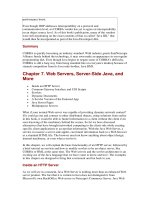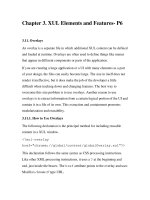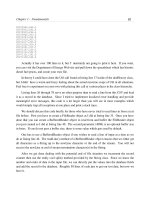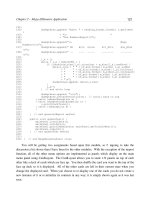About Java and xBaseJ- P6
Bạn đang xem bản rút gọn của tài liệu. Xem và tải ngay bản đầy đủ của tài liệu tại đây (1.15 MB, 20 trang )
Chapter 2 – MegaZillionaire Application
Figure 8 Entry form
One thing which might not be obvious is the “ Deleted:” prompt. You cannot enter a value
here, but when a record which has been flagged for deletion is displayed “*” will display in this
box. Unless you use a lot of VCRtype software the row of buttons containing lessthan and
greaterthan signs might not be intuitive. A single lessthan sign moves towards the beginning,
multiples move to the very beginning. A single greaterthan moves towards the end and multiples
move to the very end.
It probably wasn't the best choice of labels, but “OK” performs either an Add or an Update
depending upon which mode you are currently in. There is no button to set the mode per se. If
you find a record via the “Find” button or one of the navigation buttons, you will be in find mode.
By default the screen starts out in add mode. If you need to get back to add mode you must
“Clear,” which will both clear all entries on the screen and reset the screen back to add mode.
101
Chapter 2 – MegaZillionaire Application
Figure 9 Browse form
Although it is against my religion to design applications which load every record from a
database into a spreadsheet, that is what end users have come to expect thanks to the world's
lowest quality software vendor, Microsoft. Nobody with even the tiniest shred of computer
science education would ever consider getting users
used
to seeing data displayed this way. It
works only under the condition which lets it work here: a very limited set of data stored locally
and access read only. I did it because most of you were going to whine and snivel about wanting
to do it.
Most of you reading this book will not have had professional software development training.
I cover this topic quite a bit in the OpenVMS Application Developer book (ISBN13
9780977086603) and the SOA book (ISBN13 9780977086665). The spreadsheet design
is horribly inefficient. I'm not talking about the code to create the spreadsheet itself, I'm talking
about the concepts behind the design. It is a resourceintensive pig that imposes severe data
access restrictions by requiring either exclusive access to the entire data set, or a live data monitor
communicating with the database to monitor for any and all record changes.
102
Chapter 2 – MegaZillionaire Application
The xBASE architecture doesn't lend itself to multiuser access without an intervening
database engine locking all files and providing all access. We don't have that, so we are already
living in multiuser Hell, and choose to handle the multiuser problem procedurally by not
creating the data files on a server and telling users not to run multiple instances of our application.
It used to be easy to restrict applications to nonnetwork file storage. You had to either be
working at a large corporation or be an Uber Geek yourself to install and configure a Netware file
server in your own small business or home. Then Microsoft came out with their own pathetic
excuse for a Netware replacement, lowering the skill level and exponentially lowering the bar on
quality. Today, even a blind squirrel can find the acorn. For well under $1000 the average user
can buy a network storage device, plug it in, follow a short list of configuration commands, and
have their own file server. Security on these devices tends to be almost nonexistent, given that
they are created from a “share everything” viewpoint for nontechnical users. Many of these
devices cost under $500 and provide nearly 1TB of storage. Unlike Netware, these file servers
don't provide an indexed file system. Btrieve Technologies, Inc. really needs to get into this
personal file server market. There are probably still a lot of tools out there which support Btrieve
and let end users create things by picking and pointing.
Memory and bandwidth issues simply cannot be overlooked when designing an application. I
provided only a few hundred records for our test database and I'm creating the files locally. What
happens when you modify this application to open a DBF and NDX which are on a Web site or
remote file server? Unless you are on dialup, you probably have enough bandwidth to transfer
fewer than 400 records. How about when the file is approaching 2GB and the end user is on a
satellite connection with a 120MB per day bandwidth restriction? One must always take such
things into consideration when designing an application or applet which could have its data hosted
remotely.
Ordinarily, a screen like the browse screen would be designed to display five to ten records,
and it would have a search prompt. Perhaps the search prompt would also have a combo box
allowing a user to select a search field, otherwise the search would be on the primary key. When
a user clicked on the Search or Find button the application would perform indexed look up logic
against the database and display up to 5 records. While that design may not seem as slick as being
able to drag a scroll bar through a spreadsheet, it works at all resource levels. The poor Schmoe
who was given a corporate desktop running Windows XP with only 256Meg of RAM can use it
just as easily as the power user and their 2+Ghz multicore CPU with 4GB or RAM.
103
Chapter 2 – MegaZillionaire Application
2.2
2.22.2
2.22.2
2.2
Supporting Classes
Supporting ClassesSupporting Classes
Supporting ClassesSupporting Classes
Supporting Classes
MegaDBF.java
1) package com.logikal.megazillxBaseJ;
2)
3) import java.io.*;
4) import java.util.*;
5) import org.xBaseJ.*;
6) import org.xBaseJ.fields.*;
7) import org.xBaseJ.Util.*;
8) import org.xBaseJ.indexes.NDX;
9)
10) public class MegaDBF {
11)
12) // variables used by the class
13) //
14) private DBF aDB = null;
15)
16) // fields
17) public DateField Draw_Dt = null;
18) public NumField No_1 = null;
19) public NumField No_2 = null;
20) public NumField No_3 = null;
21) public NumField No_4 = null;
22) public NumField No_5 = null;
23) public NumField Mega_No = null;
24)
25) // file names
26) public final String DEFAULT_DB_NAME = "megadb.dbf";
27) public final String DEFAULT_K0_NAME = "megadbk0.ndx";
28)
29) // work variables
30) private boolean continue_flg = true;
31) private boolean dbOpen = false;
32)
33) // result codes
34) public static final int MEGA_SUCCESS = 1;
35) public static final int MEGA_DUPE_KEY = 2;
36) public static final int MEGA_KEY_NOT_FOUND = 3;
37) public static final int MEGA_FILE_OPEN_ERR = 4;
38) public static final int MEGA_DEVICE_FULL = 5;
39) public static final int MEGA_NO_CURRENT_REC = 6;
40) public static final int MEGA_DELETE_FAIL = 7;
41) public static final int MEGA_GOTO_FAIL = 8;
42) public static final int MEGA_DB_CREATE_FAIL = 9;
43) public static final int MEGA_INVALID_DATA = 10;
44) public static final int MEGA_END_OF_FILE = 11;
45)
46)
47) //;;;;;;;;;;;;;;;;;;;;;;;;;;;;;;;;;;;;;;;;
48) // Method to populate known class level field objects.
49) // This was split out into its own method so it could be used
50) // by either the open or the create.
51) //;;;;;;;;;;;;;;;;;;;;;;;;;;;;;;;;;;;;;;;;
52) private void attach_fields( boolean created_flg) {
53) try {
54) if ( created_flg) {
55) //Create the fields
56) Draw_Dt = new DateField( "DrawDt");
57) No_1 = new NumField( "No1", 2, 0);
58) No_2 = new NumField( "No2", 2, 0);
59) No_3 = new NumField( "No3", 2, 0);
104
Chapter 2 – MegaZillionaire Application
60) No_4 = new NumField( "No4", 2, 0);
61) No_5 = new NumField( "No5", 2, 0);
62) Mega_No = new NumField( "MegaNo", 2, 0);
63)
64) //Add field definitions to database
65) aDB.addField(Draw_Dt);
66) aDB.addField(No_1);
67) aDB.addField(No_2);
68) aDB.addField(No_3);
69) aDB.addField(No_4);
70) aDB.addField(No_5);
71) aDB.addField(Mega_No);
72)
73) } else {
74) Draw_Dt = (DateField) aDB.getField("Drawdt");
75) No_1 = (NumField) aDB.getField("No1");
76) No_2 = (NumField) aDB.getField("No2");
77) No_3 = (NumField) aDB.getField("No3");
78) No_4 = (NumField) aDB.getField("No4");
79) No_5 = (NumField) aDB.getField("No5");
80) Mega_No = (NumField) aDB.getField("MegaNo");
81) }
82)
83) } catch ( xBaseJException j){
84) j.printStackTrace();
85) } // end catch
86) catch( IOException i){
87) i.printStackTrace();
88) } // end catch IOException
89) } // end attach_fields method
90)
91) //;;;;;;;;;;;;;;;;;;;;;;;;;;;;;;;;;;;;;;;;
92) // Method to close the database.
93) // Don't print stack traces here. If close fails it is
94) // most likely because the database was never opened.
95) //;;;;;;;;;;;;;;;;;;;;;;;;;;;;;;;;;;;;;;;;
96) public void close_database() {
97) if (!dbOpen)
98) return;
99) try {
100) if (aDB != null) {
101) aDB.close();
102) dbOpen = false;
103) }
104) } catch (IOException i) {}
105)
106) } // end close_database method
107)
108) //;;;;;;;;;;;;;;;;;;;;;;;;;;;;;;;;;;;;;;;;
109) // Method to create a shiny new database
110) //;;;;;;;;;;;;;;;;;;;;;;;;;;;;;;;;;;;;;;;;
111) public void create_database() {
112) try {
113) //Create a new dbf file
114) aDB=new DBF(DEFAULT_DB_NAME,true);
115)
116) attach_fields(true);
117)
118) aDB.createIndex(DEFAULT_K0_NAME,"DrawDt",true,true);
119) dbOpen = true;
120) } catch( xBaseJException j){
121) System.out.println( "xBaseJ Error creating database");
122) j.printStackTrace();
105
Chapter 2 – MegaZillionaire Application
123) continue_flg = false;
124) } // end catch
125) catch( IOException i){
126) System.out.println( "IO Error creating database");
127) i.printStackTrace();
128) continue_flg = false;
129) } // end catch IOException
130) } // end create_database method
131)
132)
133) //;;;;;;;;;;;;;;;;;;;;;;;;;;;;;;;;;;;;;;;;
134) // method to retrieve a copy of the DBF object
135) //;;;;;;;;;;;;;;;;;;;;;;;;;;;;;;;;;;;;;;;;
136) public DBF getDBF() {
137) return aDB;
138) } // end getDBF method
139)
140) //;;;;;;;;;;;;;;;;;;;;;;;;;;;;;;;;;;;;;;;;
141) // Method to test private flag and see
142) // if database has been successfully opened.
143) //;;;;;;;;;;;;;;;;;;;;;;;;;;;;;;;;;;;;;;;;
144) public boolean isOpen() {
145) return dbOpen;
146) } // end ok_to_continue method
147)
148) //;;;;;;;;;;;;;;;;;;;;;;;;;;;;;;;;;;;;;;;;
149) // Method to open an existing database and attach primary key
150) //;;;;;;;;;;;;;;;;;;;;;;;;;;;;;;;;;;;;;;;;
151) public int open_database() {
152) int ret_val = MEGA_SUCCESS;
153)
154) try {
155)
156) //Create a new dbf file
157) aDB=new DBF(DEFAULT_DB_NAME);
158)
159) attach_fields( false);
160)
161) aDB.useIndex( DEFAULT_K0_NAME);
162) dbOpen = true;
163) reIndex(); // gets around problem with stale index info
164)
165) } catch( xBaseJException j){
166) continue_flg = false;
167) } // end catch
168) catch( IOException i){
169) continue_flg = false;
170) } // end catch IOException
171)
172) if (!continue_flg) {
173) continue_flg = true;
174) System.out.println( "Open failed, attempting create");
175) create_database();
176) } // end test for open failure
177)
178) if (isOpen())
179) return MEGA_SUCCESS;
180) else
181) return MEGA_FILE_OPEN_ERR;
182) } // end open_database method
183)
184) //;;;;;;;;;;;;;;;;;;;;;;;;;;;;;;;;;;;;;;;;
185) // Method to re-index all of the associated index files.
106
Chapter 2 – MegaZillionaire Application
186) //;;;;;;;;;;;;;;;;;;;;;;;;;;;;;;;;;;;;;;;;
187) public void reIndex() {
188) if (aDB != null) {
189) if (isOpen()) {
190) try {
191) NDX n = null;
192) for (int i=1; i <= aDB.getIndexCount(); i++) {
193) n = (NDX) aDB.getIndex( i);
194) n.reIndex();
195) }
196) } catch( xBaseJException j){
197) j.printStackTrace();
198) } // end catch
199) catch( IOException i){
200) i.printStackTrace();
201) } // end catch IOException
202) } // end test for open database
203) } // end test for initialized database object
204) } // end reIndex method
205)
206) public int find_EQ_record( String d) {
207) int ret_val = MEGA_SUCCESS;
208) boolean perfect_hit;
209)
210) if (!dbOpen)
211) return MEGA_FILE_OPEN_ERR;
212)
213) try {
214) perfect_hit = aDB.findExact( d);
215) if ( !perfect_hit) {
216) System.out.println( "missed");
217) System.out.println( "Current Record " +
aDB.getCurrentRecordNumber());
218) ret_val = MEGA_KEY_NOT_FOUND;
219) }
220) } catch( xBaseJException j){
221) System.out.println( j.getMessage());
222) ret_val = MEGA_KEY_NOT_FOUND;
223) } // end catch
224) catch( IOException i){
225) ret_val = MEGA_KEY_NOT_FOUND;
226) } // end catch IOException
227)
228) return ret_val;
229) } // end find_EQ_record method
230)
231) public int find_GE_record( String d) {
232) int ret_val = MEGA_SUCCESS;
233)
234) if (!dbOpen)
235) return MEGA_FILE_OPEN_ERR;
236)
237) try {
238) aDB.find( d);
239) } catch( xBaseJException j){
240) ret_val = MEGA_KEY_NOT_FOUND;
241) } // end catch
242) catch( IOException i){
243) ret_val = MEGA_KEY_NOT_FOUND;
244) } // end catch IOException
245)
246) return ret_val;
247) } // end find_GE_record method
107
Chapter 2 – MegaZillionaire Application
248)
249) } // end class MegaDBF
This is a good example of the farthest most of you will go when writing your own classes for
application reuse, be it reuse within the application or other applications. Once again you will
see the open, close, and create methods have been provided. A hidden attach_fields() method
ensures we always have the same field names. At the end of the source listing I added methods to
find a matching key and find a key which is greater than or equal to a provided key value. I did
not provide methods for deletion, but I did provide the reIndex() method. The nice thing about
the reIndex() method is that you will probably cut and paste it into every DBF class you create.
As long as you make the DBF variable name aDB this method will always work for you.
Listing lines 56 through 62 might just provide some interesting confusion. I chose the
externally visible column names deliberately. They are consistent with the names used in the
other books of this series. Given the naming restrictions xBASE enforces on column names, you
will note that the actual physical column names don't match the externally visible. I did not want
to experiment with trying to make the “ _” character work as a column name. Some character sets
for some countries use the “_” as the “de lete” character. I ran into this years ago. When I'm
working with something like a relational engine I will use the “_” in a column name. The engine
protects me from the possibility of the character set changing.
We should discuss listing line 163 before moving on. I would like to say I originally
designed this application in such a way as to insulate it from changes made by others. That was
my original intention. I, however, did not originally have the reIndex() being called on each open.
I had to do this because of a bug in the xBaseJ library which apparently I introduced while fixing
another bug. Thankfully the original developer ran the debugger on an example I provided and
found where things went bad. When you initially opened an NDX file, something was not loaded
correctly with the index. You can get around this problem by moving a value, any value, to the
Field object named in the key, or you can call reIndex(). Calling reIndex() at the time of open
won't be a big burden on most applications having fewer than 5000 records. Today's computer
speeds are fast enough that you probably won't even notice. Unless you are the only person using
your application on your computer, you should always call reIndex() after opening an existing
NDX file anyway.
StatElms.java
1) package com.logikal.megazillxBaseJ;
2)
3) public class StatElms extends Object {
4) public int elmNo, hitCount, lastDrawNo, sinceLast, currSeq,
5) longestSeq, maxBtwn;
6) public double pctHits, aveBtwn;
7) } // end StatElms class
108









